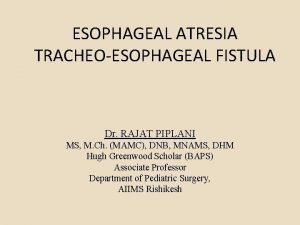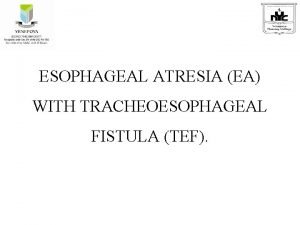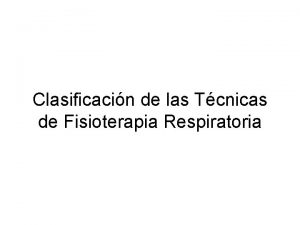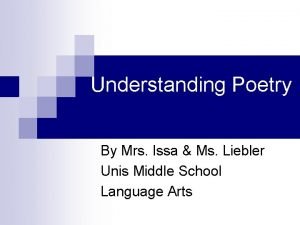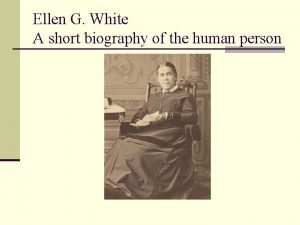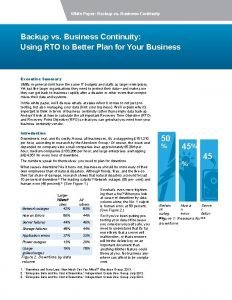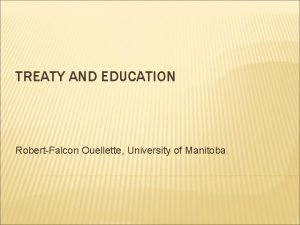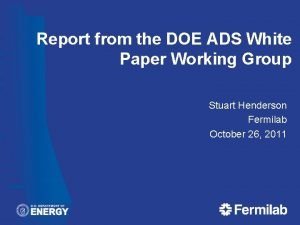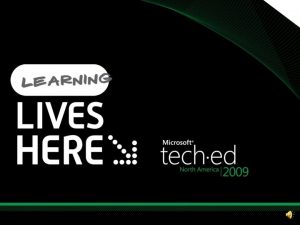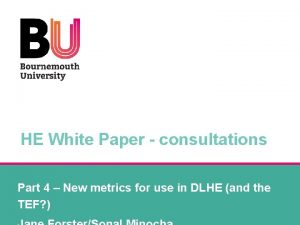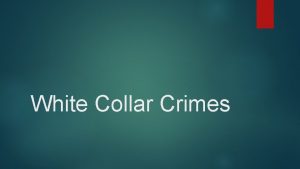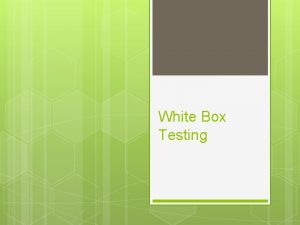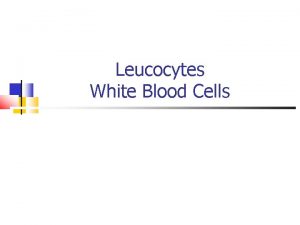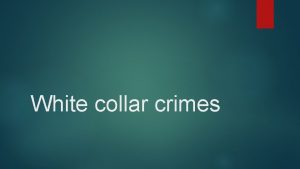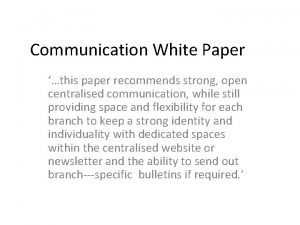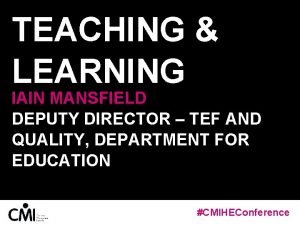HE White Paper consultations Part 2 TEF quality
















- Slides: 16

HE White Paper - consultations Part 2 - TEF quality assessment Tim Mc. Intyre-Bhatty

Political context “This patchiness in the student experience within and between institutions cannot continue. There is extraordinary teaching that deserves greater recognition. And there is lamentable teaching that must be driven out of our system. It damages the reputation of UK higher education and I am determined to address it. ” Jo Johnson, 9 th September 2015 “Panel members will be looking for evidence that the environment and support provided allows all students to feel that their individual learning needs are recognised, understood and met, reflected in rates of retention. ” TEF Year 2 consultation, May 2016 “The student experience is still a positive one, but students as consumers are becoming more demanding. They are looking for evidence of value for money and are prepared to put in the effort themselves as long as they feel this is matched by being offered an involved experience with high-quality teaching, staff who continuously develop their skills, and appropriate levels of contact hours for the subject they choose. ” HOPI 2016 Student Academic Experience Survey, June 2016

A focus on student satisfaction “Overall, how would you asses the quality of the teaching you experienced on your course? - Very good/good – 76% - Acceptable – 18% - Poor – 5%” BIS analysis of Graduate views on Teaching Quality in HE, May 2016 “Overall UG students are satisfied with their course experience but there is a decline over time in those who are “very satisfied”. ” “One of the specific reasons for expectations being met…is the support provided to study independently “ HOPI 2016 Student Academic Experience Survey, June 2016

Aspects of quality “Students often equate the value they receive with excellent teaching, being taught by staff who continually develop their teaching skills, in environments where investment has been made in the resources available to support this” (2016 HEPI-HEA Student Academic Experience Survey) “Teaching quality is best considered in the context of student’s learning. The outcomes of a student’s learning are determined not only by the quality of teaching they experience but also by the additional support for learning that is available and what the students themselves put into their studies, supported and facilitated by the provider. ” (White Paper)

TEF assessment framework

The challenge in year 2 % Satisfied BU Question No. Question 2014 2015 Sector Average Change 2015 Change BU vs Sec Avgas 1 Staff are good at explaining things. 85 86 p 1 90 to 0 q -4 2 Staff have made the subject interesting. 79 80 p 1 84 p 1 q -4 3 Staff are enthusiastic about what they are teaching. 83 83 to 0 88 to 0 q -5 4 The course is intellectually stimulating. 81 79 q -2 86 to 0 q -7 5 The criteria used in marking have been clear in advance. 68 69 p 1 77 p 1 q -8 6 Assessment arrangements and marking have been fair. 69 68 q -1 78 p 1 q -10 7 Feedback on my work has been prompt. 66 66 to 0 70 p 1 q -4 8 I have received detailed comments on my work. 67 68 p 1 72 p 1 q -4 9 Feedback on my work has helped me clarify things I did not understand. 57 60 p 3 68 p 2 q -8 10 I have received sufficient advice and support with my studies. 75 75 to 0 80 p 1 q -5 11 I have been able to contact staff when I needed to. 85 83 q -2 87 to 0 q -4 12 Good advice was available when I needed to make study choices. 75 74 q -1 78 p 1 q -4 13 The timetable works efficiently as far as my activities are concerned. 80 78 q -2 81 to 0 q -3 14 Any changes in the course or teaching have been communicated effectively. 73 74 p 1 79 p 1 q -5 15 The course is well organised and is running smoothly. 67 65 q -2 77 to 0 q -12 16 The library resources and services are good enough for my needs. 87 83 q -4 88 p 1 q -5 17 I have been able to access general IT resources when I needed to. 88 86 q -2 89 p 1 q -3 18 I have been able to access specialised equipment, facilities or rooms when I needed to. 81 80 q -1 82 to 0 q -2 19 The course has helped me to present myself with confidence. 80 79 q -1 82 p 1 q -3 20 My communication skills have improved. 85 84 q -1 85 p 1 q -1 21 As a result of the course, I feel confident in tackling unfamiliar problems. 81 80 q -1 83 p 1 q -3 22 Overall Satisfaction 80 79 q -1 86 to 0 q -7 *highlighted questions will be used in TEF 17/18 over 3 years

Overall Satisfaction by Department

Provider submissions Providers can put forward additional evidence that supports its case against the criteria. This evidence can be qualitative and/or quantitative. The submission may refer to and build upon evidence explored as part of broader quality assurance arrangements but should not duplicate it. The emphasis in the provider submission should be on demonstrating the impact and effectiveness of teaching and its outcomes. Assessors will be free to seek clarification and verification of the information and evidence covered in the submission but will not otherwise engage with the provider. All applications will be published. Assessors will be looking for evidence of how far a provider demonstrates teaching and learning excellence across its entire provision. The submission should therefore avoid focusing on successful but highly localised practices that affect a relatively small number of students studying on particular courses or in particular departments. Providers may also provide contextual information, including any mitigating factors that explains performance against the core metrics. There is a proposed 15 page maximum on the length of a provider submission. Copies of, or links to, primary evidence should not be included. Q 7: Do you agree with the proposed approach for the provider submission? ☐Yes ☐No ☐ Not sure Do you agree with the proposed 15 page limit? ☐Yes ☐No ☐ Not sure Please explain your reasons and outline any alternative suggestion

Teaching quality Criteria The extent to which… Teaching provides effective stimulation and challenge and encourages students to engage Institutional culture recognises and rewards excellent teaching Course design, development, standards and assessment are effective in stretching students to develop knowledge, skills and attributes that reflect their full potential Panel members will be looking for evidence that students report high levels of satisfaction with teaching and are sufficiently challenged and engaged. Evidence might include results of student satisfaction and engagement surveys (beyond the core metrics), collection and use of students’ feedback, and teaching observation schemes. How effectively a provider uses innovative or creative approaches could also be a feature. Panel members will be looking for evidence that the leadership, strategy and ethos promotes and values teaching excellence. Evidence might include initial and continuing professional development for teaching and academic support staff, reward and recognition, promotion and progression opportunities, and the level of experience and contractual status of staff involved in teaching. Panel members will be looking for evidence that course design and development presents a sufficient degree of challenge and allows for the development of knowledge, skills and attributes at a high level. Evidence might include results of student satisfaction surveys (beyond the core metrics), feedback from external examiners and professional accreditation. It may also include evidence of appropriate levels of contact time and independent study, and weighted measures of teaching class size, as well as how the institution is monitoring and, where appropriate, addressing grade inflation. Assessment and feedback are used effectively in supporting students’ development, progression and attainment Panel members will be looking for evidence that all students receive feedback on assessed work which is effective in enhancing their learning. Evidence may include the impact and effectiveness of assessment and feedback practices on students’ progression and attainment, which is likely to reflect factors such as timeliness and accessibility. Q 1: Do you agree with the criteria proposed above? ☐Yes ☐No ☐ Not sure Please outline your reasons and suggest any alternatives or additions. Question 8 asks about the type of evidence that will be used to assess the criteria so please put forward your comments on the evidence base in response to that question.

Provider Evidence – Teaching Quality Impact and effectiveness of involving students in teaching evaluation e. g. collecting and acting on their feedback Impact and effectiveness of schemes focused on monitoring and maximising students’ engagement with their studies e. g. the UK Engagement Survey (UKES) and other mechanisms Recognition of courses by professional, statutory and regulatory bodies (PSRBs) How the provider is successfully identifying, addressing and preventing grade inflation Quantitative information on teaching intensity, such as weighted contact hours Impact and effectiveness of external examining Impact and effectiveness of teaching observation schemes Impact and effectiveness of innovative approaches, new technology or educational research Recognition and reward schemes, including progression and promotion opportunities for staff based on teaching commitment and performance Quantitative information relating to the qualification, experience and contractual basis of staff who teach Impact and effectiveness of feedback initiatives aimed at supporting students’ development, progression and achievement Q 8: Without the list becoming exhaustive or prescriptive, we are keen to ensure that the examples of additional evidence included above reflect a diversity of approaches to delivery. Do you agree with the examples? ☐Yes ☐No ☐ Not sure Please outline your reasons and suggest any additions or alternatives.

Learning environment Criteria The extent to which… The effectiveness of resources designed to support students’ learning and aid the development of independent study and research skills The learning environment is enriched by linkages between teaching and scholarship, research or professional practice Students’ academic experiences are tailored to the individual, maximising rates of retention Panel members will be looking for evidence that resources (both physical and virtual, and in-curricular and extra-curricular) are effective in supporting students’ learning. Evidence may include use of student feedback to identify initiatives and interventions that have been found to be effective and student feedback on the quality of the facilities (both virtual and physical). Panel members will be looking for evidence that the provider identifies and makes use of links between teaching and scholarship, research or professional practice (one or more) in a way that impacts positively on students’ academic experiences. Evidence may include course validation and review that reflects the latest developments in one or more of the domains identified, use of external consultants from business, industry or the professions, work placements or work experience, involvement of staff who teach in research, scholarship or professional practice, and involvement of students in real research projects Panel members will be looking for evidence that the environment and support provided allows all students to feel that their individual learning needs are recognised, understood and met, reflected in rates of retention. This may be characterised by mutually beneficial interaction between students and teaching or academic support staff. Evidence may include effective use of academic induction, individualised feedback on assessed work, opportunities for student to student interaction, use of learner analytics, and use of personal development planning. Q 1: Do you agree with the criteria proposed above? ☐Yes ☐No ☐ Not sure Please outline your reasons and suggest any alternatives or additions. Question 8 asks about the type of evidence that will be used to assess the criteria so please put forward your comments on the evidence base in response to that question.

Provider Evidence – Learning Environment Impact and effectiveness of initiatives aimed at supporting the transition into and through a higher education course Quantitative information demonstrating proportional investment in teaching and learning infrastructure Use and effectiveness of learner analytics in tracking and monitoring progress and development Extent, nature and impact of employer engagement in course design and/or delivery Extent and impact of student involvement in or exposure to the latest developments in research, scholarship or professional practice (one or more) Q 8: Without the list becoming exhaustive or prescriptive, we are keen to ensure that the examples of additional evidence included above reflect a diversity of approaches to delivery. Do you agree with the examples? ☐Yes ☐No ☐ Not sure Please outline your reasons and suggest any additions or alternatives.

Student outcomes and learning gain Criteria The extent to which… Students achieve their educational and professional goals, including progression to further study or employment Panel members will be looking for evidence that graduates are equipped with the sorts of knowledge, skills and attributes that allow them to progress successfully to further study or employment (particularly highly skilled employment). Evidence is likely to include employment outcomes and progression to further study. Students acquire knowledge, skills and attributes that prepare them for their personal and professional lives Panel members will be looking for evidence of broader educational and professional outcomes. Evidence may include input measures such as employer engagement in the curriculum, course accreditation by professional regulatory or statutory bodies and extra-curricular activities designed to enhance employability and transferable skills. Evidence may also include the impact of using methods such as Grade Point Average (GPA) to record students’ achievement. Positive outcomes are achieved Panel members will be looking for evidence that the provider actively monitors and addresses for students from all differences between different groups of students in their development, attainment and progression. backgrounds, in particular Evidence may include approaches and interventions that have been shown to be effective at those from disadvantaged maximising outcomes for all students and tackling evidence of any differential outcomes. backgrounds or those who are at greater risk of not achieving positive outcomes Q 1: Do you agree with the criteria proposed above? ☐Yes ☐No ☐ Not sure Please outline your reasons and suggest any alternatives or additions. Question 8 asks about the type of evidence that will be used to assess the criteria so please put forward your comments on the evidence base in response to that question.

Provider Evidence – Student Outcome and Learning Gain Impact and effectiveness of initiatives aimed at understanding, assessing and improving retention and completion Learning gain and distance-travelled by students Evidence of longer-term employment outcomes and progression of graduates including into highly-skilled employment Evidence and impact of initiatives aimed at maximising graduate employability Extent of student involvement in enterprise and entrepreneurship Use and effectiveness of initiatives used to help measure and record student progress, such as Grade Point Average (GPA) Impact of initiatives aimed at closing gaps in development, attainment and progression for students from different backgrounds, in particular those from disadvantaged backgrounds or those who are at greater risk of not achieving positive outcomes. Q 8: Without the list becoming exhaustive or prescriptive, we are keen to ensure that the examples of additional evidence included above reflect a diversity of approaches to delivery. Do you agree with the examples? ☐Yes ☐No ☐ Not sure Please outline your reasons and suggest any additions or alternatives.

Commendations Responses to the Green Paper suggested that the TEF could recognise providers who excel in particular areas through awarding commendations. This would allow a provider to showcase its particular distinctiveness to students and other stakeholders. Commendations could be made to indicate excellence in the following areas, and no separate or additional evidence would be required: Excellence in research-led teaching Excellence in business engagement Excellence in achieving positive outcomes for students from disadvantaged backgrounds Excellence in innovative teaching methods Excellence in delivering part-time and/or distance learning Excellence in the support, reward and recognition available for teaching staff Q 9: Do you think the TEF should issue commendations? ☐Yes ☐No ☐ Not sure If so, do you agree with the areas identified above? ☐Yes ☐No ☐ Not sure Please indicate if you have any additional or alternative suggestions for areas that might be covered by commendations.

TEF outcomes Meets Expectations A higher education provider meets national expectations for quality and standards, reflecting the areas covered in a quality review: • the academic standard of the qualifications it offers; • the quality of teaching, resources and other educational opportunities available to students; • the approach it takes to continuous improvement of the above; • the accessibility and reliability of the information it makes available to students and the public about its educational opportunities, resources and support. Excellent An Excellent rating means that a higher education provider demonstrates excellent teaching, learning and student outcomes, building on national expectations for quality and standards, i. e. a higher education provider’s teaching and learning is excellent in three key areas: • Teaching quality • The learning environment • Student outcomes and learning gain Outstanding An Outstanding rating means that a higher education provider demonstrates outstanding teaching, learning and student outcomes, building on national expectations for quality and standards, i. e. a higher education provider’s teaching and learning is outstanding in three key areas: • Teaching quality • The learning environment • Student outcomes and learning gain Q 12 Do you agree with the descriptions of the different TEF ratings? ☐Yes ☐No ☐ Not sure Please outline your reasons and any alternative suggestions.
 Esophageal atresia type a
Esophageal atresia type a Tef types
Tef types Tef type
Tef type Master tef
Master tef Threshold fisioterapia respiratoria
Threshold fisioterapia respiratoria Two voice poem examples funny
Two voice poem examples funny Ellen g white henry nichols white
Ellen g white henry nichols white Oracle xml gateway white paper
Oracle xml gateway white paper Datto rto calculator
Datto rto calculator Treaty 5 territory map
Treaty 5 territory map Scientific white paper
Scientific white paper Rpo white paper
Rpo white paper Doe ads
Doe ads Overlay transport virtualization
Overlay transport virtualization Rdp video performance
Rdp video performance Ax 2012 best practices white paper
Ax 2012 best practices white paper White paper project
White paper project
